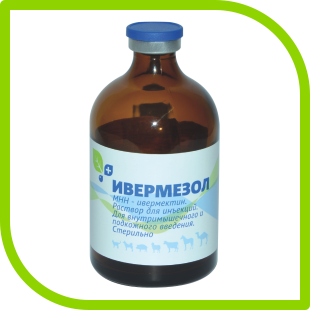For the treatment and prevention of parasitic diseases.
INSTRUCTIONS
of using Ivermezole for the prevention and therapy of parasitic diseases of animals
(Organization-developer: “BioKhimPharm”, Raduzhny, Vladimir region).
I. General information
1. Trade name of the medicinal product: Ivermezol
International nonproprietary name: ivermectin.
2. Dosage form: solution for injection.
Ivermezole in 1 ml as an active substance contains 10 mg ivermectin, as well as a solvent and a preservative.
Ivermezole is a clear, colorless or slightly yellowish liquid with a weak specific odor.
3. Ivermesol is produced in hermetically sealed glass bottles with a capacity of 10, 50, 100, 450 ml, sealed with rubber stoppers, reinforced aluminum caps, which are packed in cardboard boxes. Each package and box is marked with the manufacturer’s organization, its address and trademark, the name, the purpose, the dosage form, the name and content of the active substances, the amount of the preparation in the package, the number of packages in the box, the inscriptions: “For veterinary medicine, date of manufacture, expiry date, storage conditions, bar code, state registration number.
The shelf life of Ivermezole under the conditions of storage and transport -5 years from the date of manufacture, after opening the bottle – no more than 24 days.
4. Store the medicinal product in the manufacturer’s closed packaging in a dry, protected from light place, separate from food and feed, at temperatures from 0ºС to 30ºС.
Do not use the drug after the expiration date.
5. Ivermezole should be stored out of the reach of children.
6. Dispose of unused product with expired shelf life in accordance with legal requirements.
II. Pharmacological properties
7. Ivermezole belongs to the pharmacotherapeutic group of antiparasitic drugs.
Ivermezole has a wide spectrum of antiparasitic action, it causes death of gastrointestinal and pulmonary nematodes, lice, ixodids and scabies mites, subcutaneous and nasopharyngeal larvae, fall flies, etc.
The mechanism of action of ivermectins is based on the paralysis of the parasite musculature because of the increased isolation and binding of γ-aminobutyric acid involved in the transfer of impulses in neuromuscular synapses, which leads to disruption of the sodium channels.
Pharmacokinetics of the drug is characterized by a rapid distribution in the body and a long-term excretion, which provides a permanent parasiticidal effect for 10-14 days.
Ivermezole is excreted from the body of animals with urine and bile, in lactating animals – also with milk, in the external environment is rapidly destroyed.
Ivermezole belongs to the 3rd class of danger for warm-blooded animals (moderately hazardous substances) according to GOST 12.1.007-76. In therapeutic doses, it does not have embryotoxic, teratogenic and mutagenic effects. Toxic to fish and bees.
III. The order of application
8. Ivermezole is applied to horses, cattle, pigs, sheep, goats, deer, dogs and cats with pulmonary and gastrointestinal helminthiasis: diktiokaulez, trichostrongylatoses, strongyloidiasis, ascaridatoses, oxyuratoses, bunostomiasis, etc .; with telasiosis (eye nematodes); with hypodermatosis and estrogen (subcutaneous and nasopharyngeal gadfly), paraphilaria (section) of horses; with psoroptosis, sarcoptic disease, demodecosis (tick-scabies), sifunkulatose (lice), mallophagosis; to combat falcons and meat flies, etc. pigs – with ascariasis, esophagostamosis, trichocephalosis, strongyloidosis, stephanurosis, metastronitis and other nematodes.
Weak, depleted and sick with infectious diseases animals, as well as females, are also not subject to treatment in less than 28 days before lactation. Care should be taken with dogs and cats (no more than 2 times with an interval of 10-14 days, with carefully observe the dosage of the drug).
With caution use dogs of the collie, sheltie, bobtail (possible fatal outcome).
10. Dosage:
– horses, cattle, deer – 1.0 ml / 50 kg of live weight (0.2 mg of active ingredient per 1 kg) once, with a strong degree of lesions with psoroptosis can be repeated after 10 days;
– pigs – 1.5 ml / 50 kg of live weight (0.3 mg by dl per kg (once, if necessary twice with an interval of 10 days);
– sheep, goats – 0.2 ml / 10 kg of live weight (0.2 mg per day per 1 kg) once, and in severe cases, scabies (sheep’s psoroptosis) are re-treated in initial doses 10 days after the first .
– To dogs and cats Ivermezole is administered at the rate of 0.1 ml of the preparation for 5 kg of the animal’s weight (0.02 mg of active ingredient per 1 kg of weight).
The drug is administered intramuscularly (pigs – in the inner thigh or gluteal muscle, the rest of the animal – in the croup or neck area) or subcutaneously (in the neck or scapula, sheep – in the hairless part of the ulnar fold). Intramuscular administration of the preparation is preferred. If the volume of the injected solution is more than 10 ml, it should be administered to the animal in several places.
Against nematodes, the preparation is used for animals before stalling and in spring before going out to pasture, against larvae of gadflies – immediately after the end of the summer of gadflies, against the causative agents of arachno-entomoses – according to indications.
Each batch of the drug is pre-tested on a small group (5-10 animals). In the absence of complications within 2-3 days, all the livestock are processed.
11. In case of non-observance of recommended doses, toxicosis is possible.
12. Features of the drug drug during its first use and cancellation is not established.
13. If there are indications for two-fold treatment of animals, skip the next dose of the drug (treatment), as this may lead to a decrease in therapeutic effectiveness.
14. With increased individual sensitivity to ivermectin, some animals experience excitation, increased salivation (in dogs – vomiting), frequent bowel movements and urination, ataxia. These symptoms usually pass spontaneously without the use of therapeutic agents. Symptomatic antihistamine therapy is used to eliminate these symptoms if necessary.
15. The use of Ivermezole does not exclude the simultaneous administration of other drugs.
16. Slaughter of animals for meat is allowed no earlier than 28 days after treatment. In the case of forced slaughter, meat can be used in animal feed or for the production of meat and bone meal. Milk from animals treated with Ivertemisol should not be used for food purposes within 7 days after drug administration. It can be used to feed animals.
IV. Personal prevention measures
17. When working with Ivermezole, you should follow the general rules of personal hygiene and safety techniques provided for working with veterinary drugs.
18. When handling, use rubber gloves. If you accidentally get the drug on the skin, immediately wash it off with soap and water, if it gets in your eyes – rinse thoroughly with running water.
19. In case of contact with skin and mucous membranes, rinse with plenty of tap water. If accidentally swallowed, give a large amount of water to drink (4-5 glasses) and induce vomiting.
People with hypersensitivity to the components of the drug should avoid direct contact with the drug. In case of allergic reactions and / or accidental ingestion of the drug into the human body, you should immediately contact a medical institution.






